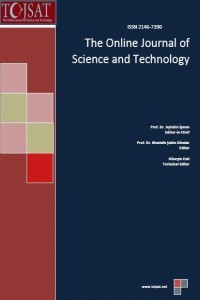Fate of Fluometuron Dissolved in Natural Waters and Exposed to Solar Light
Fate of Fluometuron Dissolved in Natural Waters and Exposed to Solar Light
photodegradation phenylureas herbicides, solar light, naturel waters,
___
- Boule, P., Bolte, M., Richard, C., (1999). Phototransformations induced in aquatic medium by FeIII, NO- 3, NO- 2 and humic substances. In: Boule, P. (Ed.), The Handbook of Environmental Chemistry. In: Editor in Chief: O. Hutzinger (Ed.), Environmental Photochemistry, vol. 2. Bayreuth (FRG), part L, pp. 181–215.
- Brezonik, P.L., Fulkerson-Brekken, J., (1998). Nitrate-induced photolysis in natural waters: controls on concentrations of hydroxyl radical photointermediates by natural scavenging agents. Environ. Sci. Technol. 32, 3004–3010.
- Buxton, G.V., Greenstock, C.L., Helman, W.P., Ross, A.B., (1988). Review of rate constants for reactions of hydrated electrons, hydrogen atoms and hydroxyl radicals in aqueous solution. J. Phys. Chem. Ref. Data 17, 513–886.
- Canonica, S., Jans, U., Stemmler, K., Hoigne´, J., (1995). Transformation kinetics of phenols in water: photosensitization by dissolved organic material and aromatic ketones. Environ. Sci. Technol. 29, 1822–1831.
- Halladja, S.; Ter Halle, A.; Aguer, J. - P.; Boulkamh, A.; Richard, C., (2007). Inhibition of humic substances mediated photooxygenation of furfuryl alcohol by 2,4,6-trimethylphenol. Evidence for reactivity of the phenol with humic triplet excited states. Environ.Sci. Technol. 41, 6066–6073.
- Lam, M.W., Young, C.J., Mabury, S.A., (2005). Aqueous photochemical reaction kinetics and transformations of fluoxetine. Environ. Sci.Technol. 39, 513–522.
- Muschal, M., Warne, M.S.J., (2003). Risk posed by pesticides to aquatic organisms in rivers of northern inland New South Wales, Australia. Hum. Ecol. Risk Assess. 9, 1765–1787.
- Stoeckel, D.M., Mudd, E.C., Entry, J.A., (1997). Degradation of persistent herbicides in Riparian wetlands. ACS Symp. Ser. 664, 114–132.
- ter Halle, A., Richard, C., (2006). Simulated solar light irradiation of mesotrione in natural waters. Environ. Sci. Technol. 40, 3842– 3847.
- Vaughan, P., Blough, N., (1998). Photochemical formation of hydroxyl radical by constituents of natural waters. Environ. Sci. Technol. 32, 2947–2953.
- Zepp, R.G., Cline, D.M., (1977). Rates of direct photolysis in aquatic environment. Environ. Sci. Technol. 11, 359–366
- ISSN: 2146-7390
- Başlangıç: 2011
- Yayıncı: The association of science, education and technology
Expert Idea on Liquid Limit and Plastic Limit Estimation with Soil Resistivity Profile
Zamri CHİK, S.M. Taohidul Islam, Hilmi SANUSİ, Mohd. Marzuki MUSTAFA
Prediction of Slope Stability Using Statistical Method and Fuzzy Logic
Tarig Mohamed, Anuar KASA, Muhammad MUKHLİSİN
Cubic Transformational High Dimensional Model Representation
The Potential for Climate Change Mitigation in Solid Waste Disposal: A Case Study of Lagos Landfills
Aboyade A.O, Rabiu A., Amigun B.
İman HASHEMİZADEH, Ahmad Zuhairi ABDULLAH
Margarida M. PİNHEİRO, Claudia S. SARRİCO, Rui A. SANTİAGO
The Role of Desalinated Water in Integrated Water Resource Management in Abu Dhabi Emirate-UAE
